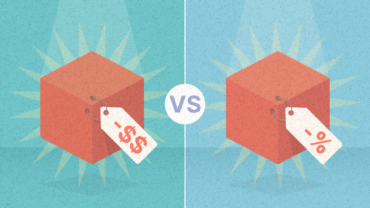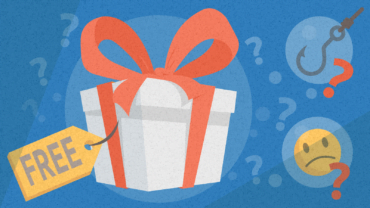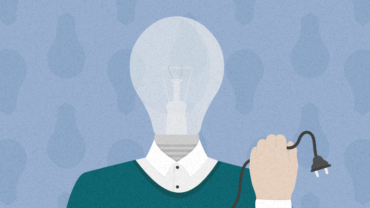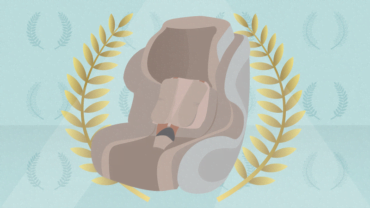The Dangers of Discounting and What You Should be Doing Instead
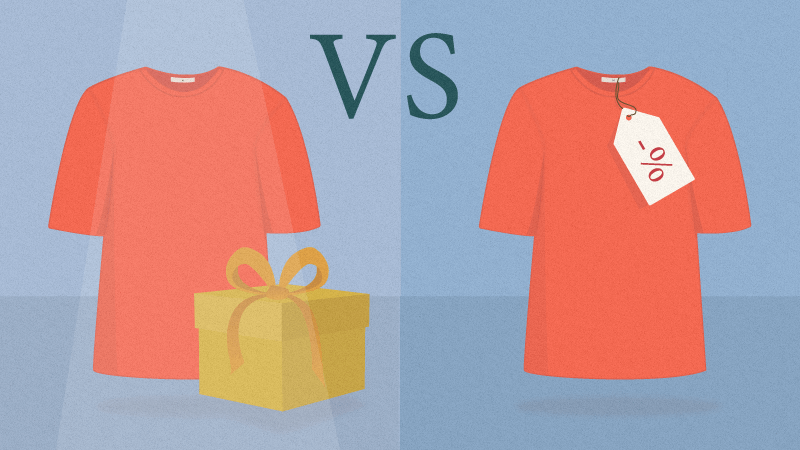
The impact of a price discount isn’t always positive, but how can you increase sales without discounting? Consumer psychology tells us the key is adding value.
In this article, you’ll discover:
- How discounts can drive customers away and tarnish your brand;
- What you should be focusing on instead;
- 3 methods to add value to your offering; and
- Which method is best for you.
The dangers of discounting
Discounts are a common way to drive sales. When we see a spike in revenue, everyone is happy, and it seems like the discount did what it was meant to do. Reducing prices is a tempting way to increase sales, and it’s often effective in the short term. However, if they are not used properly, discounts can range from being ineffective to actually harming your business.
How? Well, depending on your product, two mechanisms can come into play. Customers can either get used to the low price, or they can see the low price as evidence that the brand is poor quality.

Discover ground-breaking ideas and fascinating solutions.
Customers get used to low prices
Whenever you buy something, you know what price to expect. Two liters of milk? About €1. A desk lamp? €15-20. You might be thinking – that’s not right! But hey, that’s the point. Every person has their own expectations of how much an item should cost based on their previous experiences and the prices they see whilst shopping. These are known as ‘reference prices’.
According to some consumer studies, when you use a discount on your product too often, this lower promotional price may become merged into a customer’s reference price. This will lower their willingness to pay for your product when it is no longer discounted, as their idea of how much this product should cost has been altered.
A great example of this is the German hardware store chain Praktiker, which had stores all over Europe. To attract more customers, they decided to run a campaign where they offered a shocking 20% discount on everything except pet food. Of course, people ran to the store in hordes to take advantage of this amazing deal. Praktiker were so pleased with these results, that they soon started running the campaign every other month.
When you discount too much or too often, this new price may become expected, and drive previously happy customers away.
But then, lo and behold, customers only started coming in on the months that the promotion was running. Unsurprisingly, when the promotion was not running, customers were unwilling to pay the higher “regular” price, as it now felt like a rip-off. Their new reference prices for items at Praktiker were 20% lower.
The consequences? Praktiker, a €3bn company with 20,000 employees, went out of business in 2013. All due to their foolish use of discounting.
So be careful. When you discount too much or too often, this new price may become expected, and drive previously happy customers away.
Lowering the perceived quality of your brand
Discounting, in the form of lowered prices, can also have a negative effect on how consumers perceive your products and brand. The price-quality heuristic is one that we all know; higher prices represent higher quality.
We all fall prey to this, assuming that more effort and better resources (be they ingredients, materials, or knowledge) is the reason for a higher price. A review of over 40 studies has supported this, showing that consumers do indeed use price as a proxy for quality.
Other studies show that prices even have an unconscious effect on how consumers experience the product, with the same wine being much more pleasurable to drink (confirmed by fMRI brain scans) when it was labeled as expensive rather than cheap.
Consumers are more likely to believe that a brand that promotes more often than others is of poorer quality than others in that industry, while a brand that promotes less often is perceived to be of better quality.
This heuristic holds true for discounts. In one experiment, researchers examined the effects of promotions on brand attribution and evaluation across nine different service industries. They found that the higher the perceived amount of discounting in an industry, the more likely it is that consumers believe this is a reflection of the brand.
Consumers are also more likely to believe that a brand that promotes more often than others in its industry is of poorer quality than others in that industry, while a brand that promotes less often is perceived to be of better quality.
The damaging effect of discounts on your brand is even stronger when the customer has little to basic existing interest and industry knowledge, and when price promotions are not common in the industry you’re serving.
Maintaining your product and brand value is sacred, especially when you’re competing on quality; yet another reason to avoid discounting.
That’s not to say discounting is always bad. Price reductions can be effective in some circumstances, but if you use them too often or too regularly, they can create unhelpful expectations and send the wrong signal about product quality. Unfortunately, using discounting carelessly as a strategy is a common mistake that can seriously harm your business in the long term.
So if you choose not to use a discount, what should you use instead? Well, what about instead of a reduced-price promotion, you consider a value-added promotion?
Value-added promotions
Power of Free
Free is a lure that people are drawn to. Free things get noticed and people lose their rationality when given something that doesn’t cost a thing. Free can however reduce the perceived value and quality of your offering.
Because discounting can have unintended long-term consequences that might harm brand perception, it’s important to consider how promotions can add value. Value-added promotions are those that enhance a product or service beyond its current state. In other words, making the product offer better than the alternative, and so worth the consumer’s money.
The key to this is to deliver more than what your customers are expecting
Sounds great, but what do these value-added promotions look like?
Free gifts
The first type that springs to mind for most people is free gifts. This method is an easy way to excite potential buyers, and can have a strong effect on sales.
When something is free, people instinctively find the item more attractive and overweight its value.
When something is free, people instinctively find the item more attractive and overweight its value. In behavioral economics, this is referred to as the zero-price effect.
This free gift automatically creates an extra pulling power towards it. The key here is having the gift absolutely free, as one study showed that if you offer a gift at a low, discounted price (rather than for free), it devalues both the value of the gift and the original product.
Another key is making sure that the free gift is actually desirable. If the gift is not desirable, you will not add value to your offering. In fact, studies show that if you add an unappealing free gift to an offer it can actually lower the perceived value of the entire bundle; your original product included.
Considering these points, the best time to use this type of value-added promotion is when your product is high-end and high-price. The value added by a free gift is much higher when it is paired with an expensive product.
For example, in one study, researchers compared consumer valuations of the same free gift, a Majorica pearl bracelet, with the same product on offer: a bottle of cognac. In one condition, the cognac was low-priced, and in the other, it had a high price. Interestingly enough, participants valued the pearl bracelet 50% more when it was presented with the more expensive cognac, than when it was presented with the cheaper one. This underscores the importance of your original product offering on how much perceived value a gift can add.
Bonus features
Another type of value-added promotion is adding bonus features to your product or service. This includes things like free shipping, access to special privileges such as video content that others do not have, and physical add-ons to a product.
Research shows that people value bonuses more than discounts. For example, in one experiment, people were exposed to different deals for a car with particular features, such as a defogger and a removable sunroof. People were either exposed to the extra features as ‘free’, or viewed the car with ‘paid’ extra features, but received a discount equivalent to the cost of those features.
Despite the fact that in both of these scenarios, people would receive the exact same product for the same price, those that got the features framed as a bonus rated the car higher than those that received a discount.
An excellent real-life example of this is, of course, Amazon. Instead of giving privileges to all its customers, it has created a loyalty program that removes friction in the purchase process and provides customers with what they need. Prime members get access to benefits including deals, discounts, and first-purchase offers, as well as access to their video streaming service, that regular Amazon customers do not get.
Not only does this provide added value, but it also plays into exclusivity, which we know pleases customers. But here’s the real kicker – these bonus features are not free! Amazon has cleverly reaped the best of both worlds; adding value to their customer’s journey, whilst collecting money for access to the bonuses.
So when is this the best type of promotion to use? When you can offer multiple separate bonuses. This is because multiple gains feel greater in total value than a lump sum total of those gains. Research finds that when consumers are exposed to multiple extra benefits on a product, they prefer component pricing to bundle pricing; valuing the multiple gains more despite their total gain is the same.
For example, imagine you’re buying a new smartphone and are presented with 2 options: in addition to your phone, for no extra cost, you can receive either a) a phone case, screen protector, and a charger, or b) a pair of headphones (which cost the same as the total bonus products in option (a). Disregarding your need for/pre-owned alternatives for these items – which of these deals feels more exciting?
You almost certainly chose (a)! Even when you know that both options have the same monetary value, there is just something more exciting about having multiple items rather than just one.
Earned rewards
A final type of value-added promotion is earned rewards. Rewards are a great way to leave a strong impression on customers and entice them to come back. They create a better brand identity and can lead to a better customer experience than discounts do.
The IKEA Effect
When people put effort into something, it becomes more valuable to them than its objective value. Make your customers contribute or at least give them the feeling they contributed.
By introducing the concept of earning rewards, these rewards become more valuable to customers since they’ve had to put the effort in to gain them. This is commonly known in behavioral science as the IKEA effect.
One example of this is Starbucks. In the UK, they have their Starbucks Rewards system, whereby when you spend money with them you earn stars, which eventually add up to a free drink. Pretty standard stuff.
But where it gets interesting is that at a certain level of stars (450 for those of you who are curious), members get upgraded to ‘Gold level’. Customers at the Gold level have (through their loyalty) earned free extra shots of espresso, syrups, and whipped cream. These rewards are sweet, but by being earned they become sweeter.
Earned rewards promotions are especially effective when it comes to increasing the frequency of customers over their customer lifespan. This method should definitely be considered in industries where customer acquisition costs are higher than retention, such as utility and subscription services.
At the end of the day, each type of promotion has its uses. Discounts are better used with non-premium products that can sustain a low price and rely little on brand equity. However, this type of promotion is often carelessly misused, and can actually have a detrimental effect on your business. Luckily, there are many ways to add value to your offering without harming brand perception. The key to success is knowing how consumers think about value.
Key Takeaways
- Discounts, when misused (i.e. being used too often or too regularly), can have negative effects on expected prices and brand perception.
- Instead of focusing solely on reducing prices, you could instead be adding value to your offering; delivering beyond your customer’s expectations.
- You can do this through providing free gifts, bonus features, and earned rewards; or it can be as simple as reframing your current offering to fit these.

